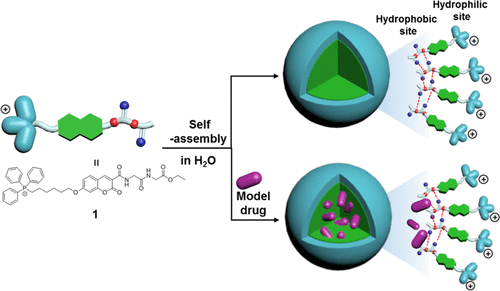当前位置:
X-MOL 学术
›
ACS Appl. Mater. Interfaces
›
论文详情
Our official English website, www.x-mol.net, welcomes your
feedback! (Note: you will need to create a separate account there.)
Self-Assembled Coumarin Nanoparticle in Aqueous Solution as Selective Mitochondrial-Targeting Drug Delivery System
ACS Applied Materials & Interfaces ( IF 8.3 ) Pub Date : 2018-01-16 00:00:00 , DOI: 10.1021/acsami.7b17711 Ji Ha Lee 1 , Ka Young Kim 1 , Hanyong Jin 2 , Yeong Eun Baek 1 , Yeonweon Choi 1 , Sung Ho Jung 1 , Shim Sung Lee 1 , Jeehyeon Bae 2 , Jong Hwa Jung 1
ACS Applied Materials & Interfaces ( IF 8.3 ) Pub Date : 2018-01-16 00:00:00 , DOI: 10.1021/acsami.7b17711 Ji Ha Lee 1 , Ka Young Kim 1 , Hanyong Jin 2 , Yeong Eun Baek 1 , Yeonweon Choi 1 , Sung Ho Jung 1 , Shim Sung Lee 1 , Jeehyeon Bae 2 , Jong Hwa Jung 1
Affiliation

|
The development of specifically targeted nanoparticles for subcellular organelles modified with a low-molecular-weight organic compound as drug nanocarriers can bring about wide applications in cancer therapy. However, their utility has been hampered by low selectivity, poor biodistribution, and limited efficiency. Herein, we report the aggregation behavior of a triphenylphosphonium-appended coumarin probe (TPP-C) in an aqueous solution and its applications as a mitochondria-targeting probe, and drug delivery carrier, which is a rare example for a low molecular-weight organic compound. The TPP-C formed homogeneous nanoparticles with small diameters in water as well as in mixtures of organic solvents and water. In pure water, the homogeneous nanoparticles induced J-aggregation, whereas in mixed solvents, the homogeneous nanoparticles induced H-aggregation. The luminescence intensities of nanoparticles originated from the aggregation-induced emission (AIE) effect in pure water and also in mixtures of organic solvents and water. These findings indicate that the AIE effect of TPP-C was dependent on the solvent. More interestingly, the TPP-C nanoparticles selectively accumulated in mitochondria. The TPP-C nanoparticles alone exhibited noncytotoxicity toward cancer cells. However, with the encapsulation of the anticancer drug doxorubicin (DOX) into the TPP-C nanoparticles, the DOX was efficiently delivered to the mitochondria. These results indicated that the proposed system demonstrates promise as a platform for future clinical medication, particularly for specific suborganelle-targeted drug delivery systems for cancer therapy.
中文翻译:

自组装香豆素纳米颗粒在水溶液中作为选择性线粒体靶向药物递送系统
用低分子量有机化合物作为药物纳米载体修饰的亚细胞细胞器的特异性靶向纳米颗粒的开发可以在癌症治疗中带来广泛的应用。但是,它们的效用因选择性低,生物分布差和效率有限而受到限制。在本文中,我们报道了三苯基-香豆素探针(TPP-C)在水溶液中的聚集行为及其作为线粒体靶向探针和药物传递载体的应用,这是低分子量有机物的罕见例子化合物。在TPP-C在水以及有机溶剂和水的混合物中形成直径较小的均质纳米粒子。在纯水中,均匀的纳米颗粒会引起J聚集,而在混合溶剂中,均匀的纳米颗粒会引起H聚集。纳米粒子的发光强度源自纯水中以及有机溶剂和水的混合物中的聚集诱导发射(AIE)效应。这些发现表明TPP-C的AIE作用取决于溶剂。更有趣的是,TPP-C纳米粒子选择性地堆积在线粒体中。单独的TPP-C纳米颗粒表现出对癌细胞的无细胞毒性。但是,将抗癌药阿霉素(DOX)封装到在TPP-C纳米颗粒中,DOX被有效地传递至线粒体。这些结果表明,所提出的系统显示出有望作为未来临床药物治疗的平台,特别是针对癌症治疗的以亚细胞器为靶标的特定药物递送系统。
更新日期:2018-01-16
中文翻译:

自组装香豆素纳米颗粒在水溶液中作为选择性线粒体靶向药物递送系统
用低分子量有机化合物作为药物纳米载体修饰的亚细胞细胞器的特异性靶向纳米颗粒的开发可以在癌症治疗中带来广泛的应用。但是,它们的效用因选择性低,生物分布差和效率有限而受到限制。在本文中,我们报道了三苯基-香豆素探针(TPP-C)在水溶液中的聚集行为及其作为线粒体靶向探针和药物传递载体的应用,这是低分子量有机物的罕见例子化合物。在TPP-C在水以及有机溶剂和水的混合物中形成直径较小的均质纳米粒子。在纯水中,均匀的纳米颗粒会引起J聚集,而在混合溶剂中,均匀的纳米颗粒会引起H聚集。纳米粒子的发光强度源自纯水中以及有机溶剂和水的混合物中的聚集诱导发射(AIE)效应。这些发现表明TPP-C的AIE作用取决于溶剂。更有趣的是,TPP-C纳米粒子选择性地堆积在线粒体中。单独的TPP-C纳米颗粒表现出对癌细胞的无细胞毒性。但是,将抗癌药阿霉素(DOX)封装到在TPP-C纳米颗粒中,DOX被有效地传递至线粒体。这些结果表明,所提出的系统显示出有望作为未来临床药物治疗的平台,特别是针对癌症治疗的以亚细胞器为靶标的特定药物递送系统。


















































 京公网安备 11010802027423号
京公网安备 11010802027423号